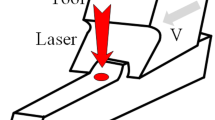Abstract
Laser hole cutting into Ti-6Al-4V alloy is carried out. Temperature and stress fields during the cutting process are predicted using the finite element code. Temporal variation of surface temperature in the region close to the kerf edge is monitored by a thermocouple and compared with the predictions. The residual stress formed in the cutting region is obtained from the XRD technique and compared with the predictions. The morphological changes around the kerf surfaces are examined incorporating optical and scanning electron microscopes. It is found that von Mises stress attains slightly higher values at the top circumference as compared to that corresponding to the bottom circumference of the hole cut. The prediction of temperature variation agrees well with the thermocouple data. The residual stress predicted also agrees with the results of the XRD technique.
Similar content being viewed by others
References
Qi LT, Wang Y, Lv SJ (2004) Study of YAG laser cutting process with titanium alloy sheet. Proc SPIE 5629:247–253
Maher W, Tong K (1998) Laser cutting of titanium with pulsed and modulated pulsed Nd:YAG lasers. Proc SPIE 3265:180–183
Watkins KG, Edwardson SP, Magee J, Dearden G, French P, Cooke RL, Sidhu J, Calder NJ (2001) Laser forming of aerospace alloys. AMTC, Seattle, Society of Automotive Engineers, Paper Number 2001-01-2610
Thawari G, Sarin Sundar JK, Sundararajan G, Joshi SV (2005) Influence of process parameters during pulsed Nd:YAG laser cutting of nickel-base superalloys. J Mater Process Technol 170:229–239
Rao BT, Kaula R, Tiwarib P, Nath AK (2005) Inert gas cutting of titanium sheet with pulsed mode CO2 laser. Optic Laser Eng 43:1330–1348
Shanjin L, Yang W (2006) An investigation of pulsed laser cutting of titanium alloy sheet. Optic Laser Eng 44:1067–1077
Almeida IA, de Rossi W, Limab MSF, Berretta JR, Nogueira GEC, Wetter NU, Vieira ND Jr (2006) Optimization of titanium cutting by factorial analysis of the pulsed Nd:YAG laser parameters. J Mater Process Technol 179:105–110
Dubey AK, Yadava V (2008) Experimental study of Nd:YAG laser beam machining—An overview. J Mater Process Technol 195:15–26
Pfeifer R, Herzog D, Hustedt M, Barcikowski S (2010) Pulsed Nd:YAG laser cutting of NiTi shape memory alloys—Influence of process parameters. J Mater Process Technol 210:1918–1925
Yilbas BS, Arif AFM, Abdul Aleem BJ (2010) Laser cutting of sharp edge: Thermal stress analysis. Optic Laser Eng 48:10–19
Akarapu R, Li BQ, Segall A (2004) A thermal stress and failure model for laser cutting and forming operations. J Fail Anal Prev 4(5):51–62
Lee SH, Ahn S (2003) A probabilistic model for crack formation in laser cutting of ceramics. JSME Int J C 46(4):1591–1597
Arif AFM, Yilbas BS (2008) Thermal stress developed during laser cutting process: consideration of different materials. Int J Adv Manuf Tech 37:698–704
Yilbas BS, Arif AFM (2008) Modeling of residual stress during laser cutting of small diameter holes, Proceedings of the IMechE. Part B: J Eng Manuf 222:1577–1587
Arif AFM, Yilbas BS, Abdul Aleem BJ (2009) Laser cutting of thick sheet metals: residual stress analysis. Optic Laser Tech 41:224–232
Yilbas BS, Arif AFM, Abdul Aleem BJ (2009) Laser cutting of holes in thick metals: development of stress field. Optic Laser Eng 47(9):909–916
Yilbas BS, Arif AFM, Aleem BJ (2009) Laser cutting of large aspect ratio rectangular blank in thick sheet metal: thermal stress analysis. Proc IMechE Part B: J Eng Manuf 223:63–71
Shuja SZ, Yilbas BS (2000) The influence of gas jet velocity in laser heating-a moving workpiece case. Proc Instn Mech Engrs Part C: J Mech Eng Sci 214:1059–1078
ABAQUS (1999) ABAQUS Theory Manual, Version 6.2. ABAQUS, Pawtucket
Risso JM, Huespe AE, Cardona A (2006) Thermal stress evaluation in the steel continuous casting process, Int J Numer Meth Eng 65(9):1355–1377
Mase GE, Mase GT (1999) Continuum mechanics for engineers, 2nd edn. CRC, New York
Li C, Thomas BG (2004) Thermo-Mechanical Finite-Element Model of Shell Be-havior in Continuous Casting of Steel. Metal Mater Trans B 35B(6):1151–1172
Anand L (1982) Constitutive equations for the rate dependant deformation of metals at elevated temperatures. ASME J Eng Mater Tech 104:12–17
Lush AM, Weber G, Anand L (1989) An implicit time –integration procedure for a set of integral variable constitutive equations for isotropic elasto viscoplasticity. Int J Plast 5:521–549
Mendelson A (1983) Plasticity: theory and applications. Krieger, Malabar
Yilbas BS, Davies R, Gorur A, Yilbas Z, Begh F, Kalkat M, Akcakoyun N (1990) Study into the measurement and prediction of penetration time during CO2 laser cutting process. Proc Instn Mech Engrs Part B 204:105–113
Khana ZA, Hadfield M, Tobe S, Wang Y (2005) Ceramic rolling elements with ring crack defects - a residual stress approach. Mater Sci Eng A 404:221–226
Author information
Authors and Affiliations
Corresponding author
Rights and permissions
About this article
Cite this article
Yilbas, B.S., Akhtar, S.S. & Karatas, C. Laser hole cutting into Ti-6Al-4V alloy and thermal stress analysis. Int J Adv Manuf Technol 59, 997–1008 (2012). https://doi.org/10.1007/s00170-011-3551-8
Received:
Accepted:
Published:
Issue Date:
DOI: https://doi.org/10.1007/s00170-011-3551-8




